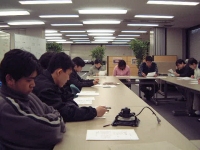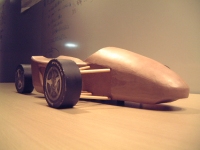About the Competition
Purpose of Competition
-
1.Purpose of Competition
To develop human resources that, through the support of government, industry, and academia, will contribute to the development and promotion of both automobile technology and industry by having the students play the main role in planning, designing, and constructing an automobile on their own in a competition of comprehensive monozukuri skills. -
2.Fundamental Policies of the Competition
as an engineering society, to provide students with an opportunity for monozukuri for the purpose of:- (1)helping the students to independently develop their comprehensive monozukuri skills.
- (2)increasing the educational value of the experience by providing the students with an opportunity for the practical application of skills and knowledge that are connected to their classroom studies.
-
3.Operating Guidelines of the Competition
- (1)To be a place where monozukuri skills are verified while placing the highest priority on ensuring safety.
- (2)To conduct the competition in connection with representatives of industry, government, and academia.
- (3)To conduct the competition with a wide range of both individual and corporate volunteers.
- (4)To conduct the competition as a non-profit, public enterprise.
- (5)To build a network of student formula competition participants that will contribute to exchange between engineers that transcends corporate frameworks.
Objectives & Background
The serious state of affairs where, in addition to the reduction in the number of students due to the falling birthrate, young people are shying away from scientific fields, might lead to the Japanese automobile industry losing its international technological competitive power in the future, reduce the competitive edge of industry in general, and result in a shortage of talented engineers. Moreover, the curricula of engineering universities is currently lacking in practical, design/drawing elements etc., thereby resulting in a shortage of opportunities for object creation.

Design meeting
On the other hand, "Formula SAE®" is held in the USa in order to provide opportunities for students to give full play to their ability and knowledge through actually creating objects. as a result, a base for nurturing human resources has been established under the cooperation of industry, academia, and governmental offices. although there are solar car conventions and robot contests as nationwide contests for object creation in Japan, there has been no design contest for giving full play to the special technologies obtained by students aiming at being active in automotive technology fields.

Production of clay model
Philosophy of the Competition
- The competition will contribute to revitalize engineering education at universities and national colleges of technology by providing opportunities for object creation.
- Students themselves will organize a team to develop and produce a small racing car in the formula style, so that they can learn the essence of object creation and its relevant processes, and feel for themselves the difficulty, interest and enjoyment of object creation.
- The competition will focus on the overall activities surrounding object creation, in other words not only the running performance, but also the marketing, the planning, the design, the production and the cost aspects of a vehicle.
- The competition is an opportunity for students to improve their own abilities and to provide an opportunity for them to present their skills as valuable resources to companies.
- Formula SAE® in the USA
- In the USA it was noticed that excellent engineers cannot be nurtured only in classrooms. SAE International has held "Formula SAE " as "a practical student education program by having students create objects" since 1981, the year after Japan exceeded the USA in production of 4-wheel vehicles. Recently, the Big 3 and SAE International organized a consortium to make the Formula SAE a magnificent and international convention, in which more than 100 university teams have participated. More than 80 % of universities accept participation in the event as a credit. The competition site, aided by the many supporting companies, also functions as an opportunity to recruit students who are aiming at being active as engineers in the automotive industry in the future.
Outline of Competition
In this competition, students themselves organize a team to plan, design and produce a small formula-style racing car. However, the competition focuses on the overall activities surrounding object creation; in other words, not only the running performance, but also the car concept and design, as well as cost and other aspects of the vehicle. While creating their cars, students acquire a wide range of practical knowledge not limited to only machinery and electronics, and also strive to increase performance, reduce costs, and improve the marketability of their vehicle. This in turn sharpens their ability to self-identify and resolve problems-skills that are nowadays expected of young engineers and students. Leadership and teamwork among members is essential as well, and students gain valuable experience through object creation "MONO-ZUKURI" while also directly experiencing the magnificence and fun of creating objects.
| Competition Category | Outline of Competition | Points | |
|---|---|---|---|
| Technical Inspection | The following tests are conducted: Compliance with vehicle safety and design requirements; Braking test (4-wheel locked state); Exhaust noise test (110 dB or less under set conditions); Tilt-table test (no fuel leakage when the vehicle is inclined at 45°, and no roll-over when the vehicle is tilted to 60° with the driver seated). | - | |
| Static Events | Cost | This competition aims to teach competitors that budget and cost management are important factors that must be considered in vehicle manufacturing activities. While comparing with the actual vehicle, checks are conducted of (1) the cost accuracy of a cost report submitted in advance and (2) manufacturing quality and workmanship, etc., of each team's vehicle. Further, the costs detailed in the report and vehicle compliance are examined. An oral question session is conducted concerning the component manufacturing process, etc., of two components that are standard purchased items. Based on this, the competitors' knowledge and level of understanding is assessed. | 100 |
| Presentation | This competition aims to assess the competitors' presentation skills. The hypothetical background scenario of the presentation is that the presenter must“sell to a director of a manufacturing company the outstanding design features of their vehicle. | 75 | |
| Design | An evaluation will be conducted based on pre-submitted design materials and the vehicle itself. This evaluation will look at (a) what type of technologies have been utilized in the vehicle, (b) what ingenious techniques and approaches have been utilized, and (c) whether the adopted technologies are suitable for market release. More specifically, an oral question session is conducted concerning such matters as the appropriateness of the design of the vehicle body and structural components, the degree of innovation, workability, ease of maintenance and assemblability. | 150 | |
| Dynamic Events | Acceleration | 0-75m acceleration test. A time competition in which 2 drivers from each team run twice each (4 times in total). | 100 |
| Skidpad | Corning performance evaluation on a figure-of-eight course. A time competition in which 2 drivers from each team run twice each (4 times in total). | 75 | |
| Autocross | Competitors run 1 full lap of a roughly 950m course that includes straights, bends, a slalom and a chicane. A time competition in which 2 drivers from each team run twice each (4 times in total). The start order of "Endurance" is determined according to the team performance of Autocross. | 125 | |
| Endurance | Competitors run 20 laps of a roughly 1,000m course that includes straights, bends, a slalom and a chicane. The vehicle's overall performance and reliability are evaluated based on running speed. | 275 | |
| Fuel Efficiency | An evaluation is conducted based on the fuel consumption during endurance running. | 100 | |
| Total Points | 1000 | ||
Rules
The Formula SAE Japan is conducted in compliance with the Formula SAE® Rules, the Local Rules of and the Participation Rules.
【 2021 Formula SAE Japan 】
- » Participation Rules Updated 2021.6.1
- » Local Rules Number 1 (Second Edition)
- » Local Rules Number 2 (Second Edition)
- » Local Rules Number 3
- » Local Rules Number 4
- » Local Rules Number 5
- » 2021 EV Design Guide
- » 2021 EV Inspection Guide
- » 2021FSAEJ_Design Score Sheet_ICV
- » 2021FSAEJ_Design Score Sheet_EV
